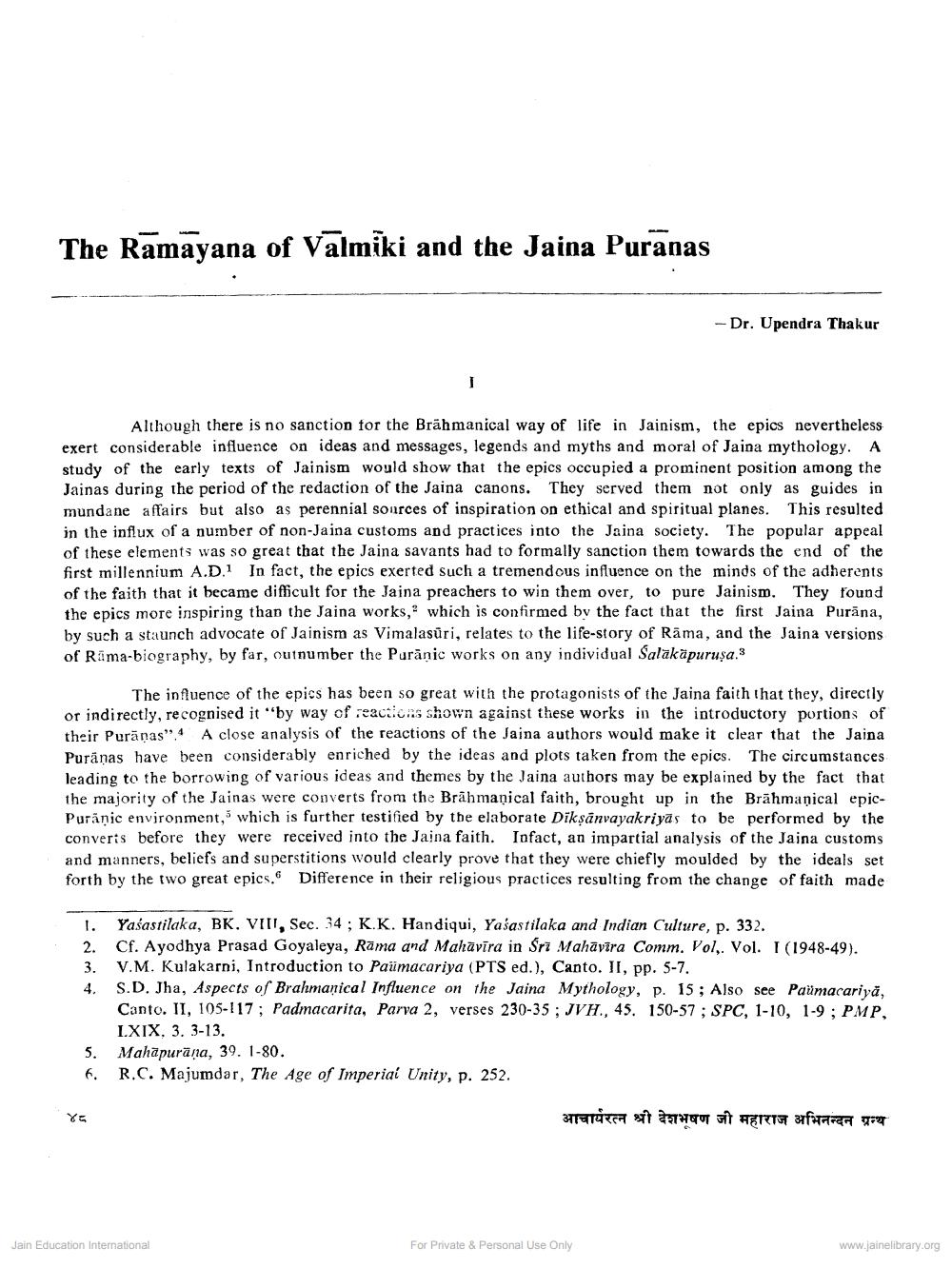________________
The Ramayana of Valmiki and the Jaina Puranas
- Dr. Upendra Thakur
Although there is no sanction for the Brāhmanical way of life in Jainism, the epics nevertheless exert considerable influence on ideas and messages, legends and myths and moral of Jaina mythology. A study of the early texts of Jainism would show that the epics occupied a prominent position among the Jainas during the period of the redaction of the Jaina canons. They served them not only as guides in mundane affairs but also as perennial sources of inspiration on ethical and spiritual planes. This resulted in the influx of a number of non-Jaina customs and practices into the Jaina society. The popular appeal of these elements was so great that the Jaina savants had to formally sanction them towards the end of the first millennium A.D. In fact, the epics exerted such a tremendous influence on the minds of the adherents of the faith that it became difficult for the Jaina preachers to win them over, to pure Jainism. They found the epics more inspiring than the Jaina works," which is confirmed by the fact that the first Jaina Purana, by such a staunch advocate of Jainism as Vimalasūri, relates to the life-story of Rāma, and the Jaina versions of Räma-biography, by far, outnumber the Puranic works on any individual Salakäpuruşa.3
The influence of the epics has been so great with the protagonists of the Jaina faith that they, directly or indirectly, recognised it by way of reactions shown against these works in the introductory portions of their Puränas 4 A close analysis of the reactions of the Jaina authors would make it clear that the Jaina Puranas have been considerably enriched by the ideas and plots taken from the epics. The circumstances leading to the borrowing of various ideas and themes by the Jaina authors may be explained by the fact that the majority of the Jainas were converts from the Brāhmaṇical faith, brought up in the Brāhmanical epicPuranic environment, which is further testified by the elaborate Diksänvayakriyas to be performed by the converts before they were received into the Jaina faith. Infact, an impartial analysis of the Jaina customs and manners, beliefs and superstitions would clearly prove that they were chiefly moulded by the ideals set forth by the two great epics. Difference in their religious practices resulting from the change of faith made
1. Yasastilaka, BK, VIT, Sec. 34; K.K. Handiqui, Yašastilaka and Indian Culture, p. 332. 2. Cf. Ayodhya Prasad Goyaleya, Rāma and Mahāvīra in Sri Mahavira Comm. Vol. Vol. 1 (1948-49). 3. V.M. Kulakarni, Introduction to Paümacariya (PTS ed.), Canto. II, pp. 5-7. 4. S.D. Jha, Aspects of Brahmanical Influence on the Jaina Mythology, p. 15; Also see Paumacariya,
Canto. II, 105-117; Padmacarita, Parva 2, verses 230-35; JVH., 45. 150-57; SPC, 1-10, 1-9 ; PMP,
I.XIX, 3. 3-13. 5. Mahāpurāna, 39. 1-80. 6. R.C. Majumdar, The Age of Imperial Unity, p. 252.
आचार्यरत्न श्री देशभषण जी महाराज अभिनन्दन ग्रन्थ
Jain Education International
For Private & Personal Use Only
www.jainelibrary.org




